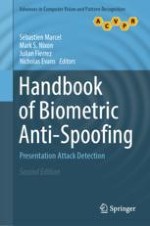2019 | OriginalPaper | Buchkapitel
7. Application of Dynamic Features of the Pupil for Iris Presentation Attack Detection
verfasst von : Adam Czajka, Benedict Becker
Erschienen in: Handbook of Biometric Anti-Spoofing
Aktivieren Sie unsere intelligente Suche, um passende Fachinhalte oder Patente zu finden.
Wählen Sie Textabschnitte aus um mit Künstlicher Intelligenz passenden Patente zu finden. powered by
Markieren Sie Textabschnitte, um KI-gestützt weitere passende Inhalte zu finden. powered by
